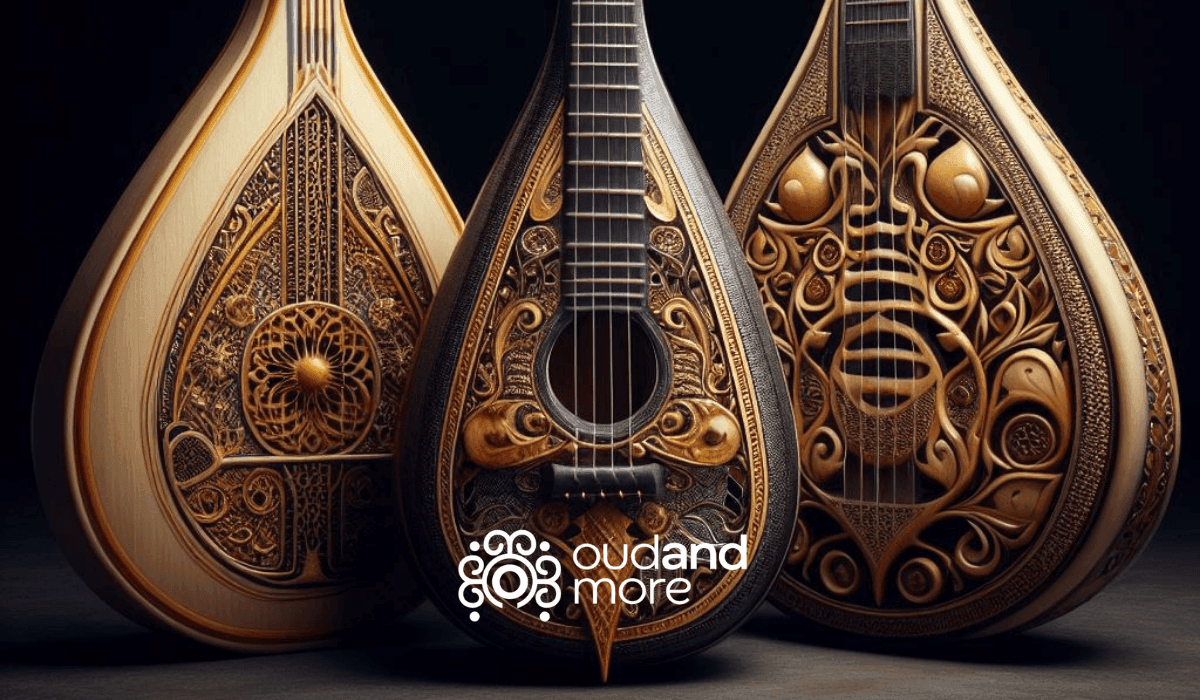The Arabic oud, Syrian oud, and Egyptian oud are three distinct variations of the oud, a musical instrument with a rich history spanning centuries. While they share common ancestry and basic characteristics, each type possesses unique qualities in terms of sound, construction, and playing style. Let’s delve deeper into their differences and explore what sets them apart.
1. Arabic Oud:
Sound Characteristics: The Arabic oud is renowned for its warm, resonant tones that evoke a sense of nostalgia and longing. It boasts a deep, rich bass register complemented by expressive mid-tones, creating a hauntingly beautiful sound. The resonance of the Arabic oud lends itself well to solo performances and intimate settings, where its emotive qualities can truly shine.
Construction: Traditional Arabic ouds typically feature a rounded back and a shorter neck compared to other variants. The body is meticulously crafted from a combination of woods, often including spruce, cedar, or mahogany, to achieve the desired tonal characteristics. Intricate decorative elements such as ornate rosettes, mother-of-pearl inlays, and elaborate wood carvings adorn the instrument, reflecting the artistry and craftsmanship of its makers.
Playing Style: Arabic oud players embrace a melodic approach to playing, emphasizing ornamentation, improvisation, and rhythmic accompaniment. Techniques such as tremolo, slides, and fingerpicking are commonly employed to add depth and expressiveness to performances. The Arabic oud’s resonant sound and versatile playing style make it a staple of traditional Arabic music, where it serves as both a solo instrument and a foundational element of ensembles.
2. Syrian Oud:
Sound Characteristics: The Syrian oud is celebrated for its bright, vibrant tones that cut through the air with clarity and precision. It possesses a pronounced treble register and a crisp, articulate sound that lends itself well to virtuosic performances and ensemble playing. The Syrian oud’s bright timbre and clear projection make it a popular choice for soloists and accompanists seeking to make a bold musical statement.
Construction: Syrian ouds typically feature a flatter back and a longer neck compared to other variants, giving them a distinct visual profile. The body is crafted from select tonewoods such as walnut, maple, or rosewood, chosen for their resonance and stability. Syrian ouds often exhibit elegant, minimalist designs, with simple rosettes and geometric patterns adorning the soundboard, reflecting the instrument’s understated sophistication.
Playing Style: Syrian oud players are known for their virtuosic technique and expressive interpretation. They employ rapid melodic runs, intricate ornamentation, and complex rhythmic patterns to captivate audiences and showcase the instrument’s versatility. Techniques such as tremolo, vibrato, and string bending are frequently utilized to push the boundaries of expression and creativity. Whether performing solo or in ensemble settings, Syrian oud players command attention with their dynamic playing style and masterful execution.
3. Egyptian Oud:
Sound Characteristics: The Egyptian oud is prized for its balanced, versatile tones that offer a perfect blend of warmth, clarity, and projection. It boasts a smooth, rounded sound characterized by well-defined mid-tones and a lyrical quality that lends itself well to a wide range of musical genres and playing styles. The Egyptian oud’s balanced sound and versatility make it a popular choice among musicians seeking an instrument that can adapt to various musical contexts.
Construction: Egyptian ouds typically feature a medium-sized body with a slightly rounded back and a moderate-length neck, striking a balance between comfort and playability. The body is crafted from high-quality tonewoods such as mahogany, walnut, or rosewood, chosen for their resonance and tonal characteristics. Egyptian ouds often exhibit understated elegance in their design, with simple, clean lines and minimal ornamentation, emphasizing functionality and playability.
Playing Style: Egyptian oud players prioritize melody, phrasing, and expression, employing subtle variations in dynamics, articulation, and timing to convey emotion and narrative depth. They emphasize clarity and precision in their playing, focusing on crafting evocative melodies and nuanced interpretations. Techniques such as glissando, trills, and harmonics are used to embellish melodic lines and add texture to performances, enhancing the overall musical experience. Whether performing classical compositions or contemporary arrangements, Egyptian oud players bring a sense of grace and sophistication to their playing, captivating audiences with their artistry and finesse.





